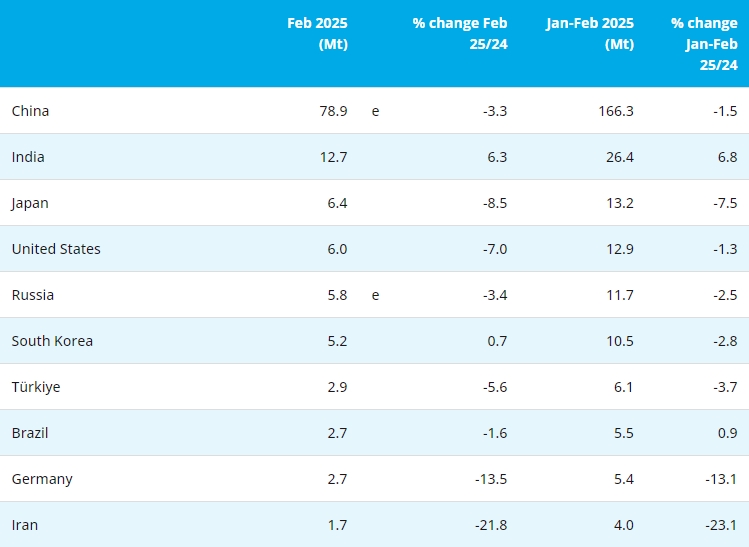Statement by worldsteel Director General Edwin Basson
Global Forum on Steel Excess Capacity (GFSEC) Ministerial meeting
Our society faces pressure on long term sustainability from many sources. A rapidly growing global population, expanding needs for many good and services, and spreading wealth that stimulates more demand, all contribute to pressure on the sustainability of modern society.
Pressure on resources is burgeoning – water, arable land, mineral resources are all showing signs of significant exploitation – and is forcing a growing part of society to ask questions about the long term sustainability of our present way of life.
CO2 emissions from all sources have become a key focus for future sustainability, and resulted in the 2015 Paris agreement with the aim to restrict temperature increase to below 2% from historic levels.
A future sustainable society will require steel. The very nature of urban development, modern water and sanitation requirements, transportation of resources, people and products between locations in an increasingly interdependent world, medical requirements and a growing desire for household goods will require steel.
Very few products are as strong, light, versatile in different applications, as re-usable and affordable as steel.
In worldsteel, we are convinced that modern society cannot be sustainable without an adequate supply of steel. After all, globally we use more than 1700 Mt of this material every year and we recycle and re-use more than 85% at the end of each lifecycle, a key circular economy attribute.
The role and impact of the steel industry in the economy
The steel industry is above all an enabling industry. Studies done by Oxford Economics, on behalf of worldsteel, have shown the steel industry to contribute an estimated 3.8% of global GDP.
Clearly, this is not equally distributed between all countries, but as more than 25% of the output of the steel industry regularly crosses intercontinental boundaries, the impact of the steel industry is not only restricted to steel producing countries – it supports economies across the globe.
Moreover, the bulk of the contribution to global GDP happens outside of the steel industry – of the 3.8% of global GDP, less than 20% is generated in the steel industry itself – the remaining 80% is generated in industries that supply to the steel industry, or industries that depend on steel as a key input to its production of goods and services.
We find the same distribution when looking at employment. Globally, we estimate the steel industry to enable 96 million jobs – about 3% of all globally employed persons according to the International Labour Organisation (ILO). Of these, a mere 6 million work directly in the steel industry. The rest work in industries that supply to the steel industry, or use steel as an input.
Without doubt the steel industry enables significant economic activity outside the boundaries of the steel industry, in addition to providing the material that in many applications support a sustainable modern society.
Requirements for long term sustainability in the steel industry
For the steel industry to continue to support the necessary development of future society, the industry needs to remain both environmentally and financially sustainable.
In a global industry with significant long term capital requirements, an appropriate balance between supply and demand remains important.
The Global Forum on Steel Excess Capacity (GFSEC) has done much over the past three years to create common understanding and action to reduce the excess of steel production capability over demand.
Balance between global supply and demand, is also a first requirement for maintaining a level playing field between all producers, wherever they may be based. For a global, competitive industry such as steel, continuous level playing principles, supported by a rules based approach to material flows, underpin long term sustainability.
The industry is thankful for the work and progress of the past few years. More needs to be done, however, and the industry is ready to continue to support this endeavour.
In order to reach environmental sustainability, the focus has shifted to the reduction of CO2 emissions during the production of steel. Given the chemical realities integral to the process of steelmaking, reducing CO2 emissions in the steel industry is no easy endeavour.
However, progress is being made and the steel industry becomes increasingly optimistic that it will meet the challenges of reducing CO2 emissions from steelmaking.
I am confident that the steel industry will remain sustainable at all levels and will be supplying steel to support a sustainable modern society. Our industry values the ability to build alignment through ventures such as the OECD Steel Committee and the Global Forum on Steel Excess Capacity. We thank you for your support.
I wish you success in the rest of your discussions.
Delivered on 26 October 2020
Edwin Basson
Director General
World Steel Association
Source: worldsteel
********************
The 2nd China Manganese Rich-Slag Technology Innovation and Policy Summit
Beijing, China Oct. 30-31 2020

Copyright © 2013 Ferro-Alloys.Com. All Rights Reserved. Without permission, any unit and individual shall not copy or reprint!
- [Editor:kangmingfei]



 Save
Save Print
Print Daily News
Daily News Research
Research Magazine
Magazine Company Database
Company Database Customized Database
Customized Database Conferences
Conferences Advertisement
Advertisement Trade
Trade












 Online inquiry
Online inquiry Contact
Contact

Tell Us What You Think